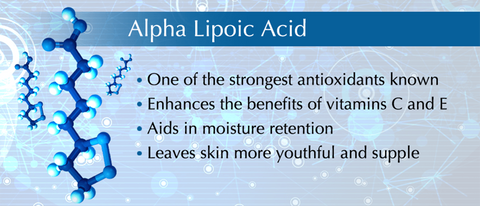There is no an product in your account
please add some product to cart.
Alpha Lipoic Acid for Diabetic Neuropathy
Posted by John Coppola on 17 Feb, 18
The Emerging Role of Alpha Lipoic Acid for Diabetic Neuropathy
The term peripheral neuropathy refers to a condition characterized by damage to nerves that are not part of the brain and spinal cord. When this condition is the result of
The debilitating condition of Diabetic neuropathy now affects an estimated 18 million Americans. Symptoms associated with diabetic neuropathy can be quite aggressive and include pain, loss of sensation (numbness), tingling, weakness and even loss of balance, typically affecting the feet or hands. Alpha-lipoic acid (ALA) is one possible treatment for diabetic neuropathy.
Alpha-lipoic acid (ALA) is a powerful antioxidant that is made by the body and found in every cell. Antioxidants attack “free radicals,” waste products created when the body turns food into energy. Free radicals cause harmful chemical reactions that can damage cells, organs
Everyone on this planet requires antioxidant protection but this is especially the case with diabetics. They require a stronger source of protection than a healthy individual and ALA fulfills this need. It has a substantial ability to squelch free radicals and aid the liver in the detoxification process. Of significant importance is ALA’s ability to restore vitamin C and E levels, two other important antioxidants helpful in nerve repair.
Benefits of Alpha Lipoic Acid and Diabetes

In several studies, alpha-lipoic acid has been shown to lower blood sugar levels, increase insulin sensitivity and aid in peripheral nerve repair.
As a matter of fact, Alpha-lipoic acid has been used for years to treat peripheral neuropathy in Germany. Both oral and intravenous ALA is approved for use in Germany for treatment of diabetic neuropathy and in the U.S.
In one study, alpha lipoic acid was indeed found to improve insulin sensitivity.
Researchers gave 600mg of controlled-release alpha lipoic acid twice a day to six non-diabetic women with
At the end of 16 weeks, the women enjoyed a 13.5 percent improvement in insulin sensitivity, as well as lower triglyceride levels.
Finally, a gold standard study—multi-center, randomized, double-blind, placebo-controlled—tested alpha lipoic acid’s benefit for type 2 diabetics with neuropathy.5(Neuropathy, a common complication of type 2 diabetes, is marked by damage to the nerves of the peripheral nervous system.)
Researchers divided 181 diabetics into four groups. As in the aforementioned study, the first received 600mg of alpha lipoic acid a day, the second received 1,200mg a day, the third received 1,800mg a day, and the fourth group received a placebo. However, this group received their dosages all at once, rather than divided throughout the day.
After five weeks, those patients taking the alpha lipoic acid enjoyed significantly greater symptom relief than the placebo group, with an average of 50 percent greater decrease in symptoms across all three alpha lipoic acid groups, as compared to just a 32 percent decrease of symptoms in the placebo group.
Researchers
Along with alleviating symptoms, research also revealed that ALA aided in nerve repair. This occurred by escalating the speed of conduction of the nerve which led to improved nerve communication and proper signaling of muscle fibers. As a result, not only were diabetic neuropathy symptoms decreased, but there was also a halt to muscular atrophy (or wasting). Other notable actions of ALA were a drop in blood glucose levels, an improvement in hemoglobin A1c levels and improvement in microcirculation. The end
One 2006 study also found that taking alpha-lipoic acid for diabetic neuropathy reduced symptoms compared to placebo. A study in Austria found that more than half of the cancer patients, that suffered from
Taking alpha-lipoic acid may help another diabetes-related condition called autonomic neuropathy, which affects the nerves to internal organs. One study found that 73 people with cardiac autonomic neuropathy, which affects the heart, showed fewer signs of the condition when taking 800 mg of alpha-lipoic acid orally compared to placebo.
Brain Function and Stroke

Because alpha-lipoic acid can pass easily into the brain, it may help protect the brain and nerve tissue. Researchers are investigating it as a potential treatment for stroke and other brain problems involving free radical damage, such as dementia.
Not All Alpha Lipoic Acid Is Created Equally
If you decide to use alpha lipoic acid, make sure you do your homework. There are two forms of alpha lipoic acid: R-alpha lipoic acid and S-alpha lipoic acid.
The R form is alpha lipoic acid in its natural state. It is this form that contains the powerful antioxidant and type 2 diabetes-fighting benefits.
The S form is a synthetic clone of alpha lipoic acid that does not exist naturally and, as a result, it is completely ineffective.
Unfortunately, many commercial alpha lipoic acid products are a 50/50 combination of the R and S forms. So be sure to do your homework and make certain you are getting 100 percent R-alpha lipoic acid.
If the manufacturer doesn’t list the form and appears to be more interested in hype than research, move on to another product.
Also, make sure the manufacturer uses good manufacturing practices (GMP) for the product and be sure you can find all ingredients contained in the product before purchasing. And, if the product contains a trademarked extract, research that
Finally, be sure the product you choose is free of preservatives, fillers, binders, excipients, flow agents, shellacs, coloring agents, gluten, yeast, lactose, and other allergens.
Once you have selected a
Some side effects with dosages of alpha lipoic acid exceeding 600 mg daily have included nausea, vomiting, and skin rash.
 This blog has been provided by Dr. John Coppola, D.C. and Dr. Valerie Monteiro, D.C. Dr. Coppola and Dr. Monteiro are the founders of the San Antonio Neuropathy Center, and Precision Sport & Spine. They are the leading experts in the field of neuropathy and specifically drug free nerve repair. They are the authors of the critically acclaimed book "Defeat Neuropathy Now .... In Spite of Your Doctor. The doctors have over 25 years of clinical experience.
This blog has been provided by Dr. John Coppola, D.C. and Dr. Valerie Monteiro, D.C. Dr. Coppola and Dr. Monteiro are the founders of the San Antonio Neuropathy Center, and Precision Sport & Spine. They are the leading experts in the field of neuropathy and specifically drug free nerve repair. They are the authors of the critically acclaimed book "Defeat Neuropathy Now .... In Spite of Your Doctor. The doctors have over 25 years of clinical experience.
If you would like to reach the doctors regarding a specific health problem, you may email them at info@bodiesrebuilt.com.
References
- Gerstein, HC et al. Effects of intensive glucose lowering in type 2 diabetes. N Engl J Med. 2008 Jun 12, 358(24), 2545-59.
- Gaziano, JM et al. Fasting triglycerides, high-density lipoprotein, and risk of myocardial infarction. Circulation. 1997 Oct 21, 96(8), 2520-5.
- Masharani, U et al. Effects of controlled-release alpha lipoic acid in lean, nondiabetic patients with polycystic ovarian syndrome. J Diabetes Sci Technol 2010 Mar 1, 4(2), 359-64.
- Jacob, S et al. Oral administration of RAC-alpha-lipoic acid modulates insulin sensitivity in patients with type-2 diabetes mellitus: a placebo-controlled pilot trial. Free Radic Biol Med. 1999 Aug, 27(3-4), 309-14.
- Ziegler, D et al. Oral treatment with alpha lipoic acid improves symptomatic diabetic polyneuropathy: the SYNDEY 2 trial. Diabetes Care. 2006 Nov 29(11), 2365-70.
- Hagen TM, et al. (R)-alpha-lipoic acid reverses the age-associated increase in susceptibility of hepatocytes to tert-butylhydroperoxide both in vitro and in vivo. Antioxid Redox Signal. 2000 Fall, 2(3), 473-83.
- Androne L, Gavan NA, Veresiu IA, Orasan R. In vivo effect of lipoic acid on lipid peroxidation in patients with diabetic neuropathy. In Vivo. 2000;14(2):327-330.
- Beitner H. Randomized, placebo controlled, double-blind study on the clinical efficacy of a cream containing 5% alpha-lipoic acid related to photoaging of facial skin. Br J Dermatol. 2003;149:841-9.
- Berkson BM. A conservative triple antioxidant approach to the treatment of hepatitis C. Combination of alpha lipoic acid (thioctic acid), silymarin, and selenium: three case histories. Med Klin. 1999;94 Suppl 3:84-89.
- Clark WM, Rinker LG, Lessov NS, Lowery SL, Cipolla MJ. Efficacy of antioxidant therapies in transient focal ischemia in mice. Stroke. 2001;32(4):1000-1004.
- Tankova T, Koev D, Dakovska L. Alpha-lipoic acid in the treatment of autonomic diabetic neuropathy (controlled, randomized, open-label study) Romanian Journal of Internal Medicine. 2004;42(2):457–464.
- Reljanovic M, Reichel G, Rett K, et al. Treatment of diabetic polyneuropathy with the antioxidant thioctic acid (α-lipoic acid): a two year multicenter randomized double-blind placebo-controlled trial (ALADIN II) Free Radical Research. 1999;31(3):171–179.
- Strokov IA, Kozlova NA, Mozolevskii IV, Myasoedov SP, Yakhno NN. The efficacy of the intravenous administration of the trometamol salt of thioctic (alpha-lipoic) acid in diabetic neuropathy. Vserossiiskoe Obshchestvo Psikhiatrov. 1999;99:18–22.
- Ziegler D, Hanefeld M, Ruhnau KJ, et al. Treatment of symptomatic diabetic polyneuropathy with the antioxidant α-lipoic acid: a 7-month multicenter randomized controlled trial (ALADIN III study) Diabetes Care. 1999;22(8):1296–1301.
- Liu F, Zhang Y, Yang M, et al. Curative effect of α-lipoic acid on peripheral neuropathy in type 2 diabetes: a clinical study. National Medical Journal of China. 2007;87(38):2706–2709.
- Ziegler D, Low PA, Litchy WJ. Efficacy and safety of antioxidant treatment with α-lipoic acid over 4 years in diabetic polyneuropathy: the NATHAN 1 trial. Diabetes Care. 2011;34:2054–2060.





